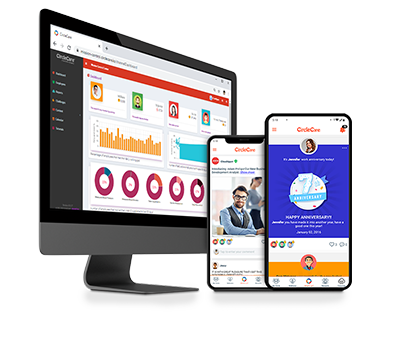Remote work isn’t a new concept. People in all kinds of professions have been doing it for an extensive period of time. However, with the ongoing state of the Coronavirus pandemic in the US, most companies are required to let their entire workforce support business remotely.
According to one recent finding, 88% of organizations have encouraged or required their employees to work from home amid the COVID-19 crisis. Furthermore, 71% of executives are worried about productivity and continuity during the pandemic.
Once your employees are on their own, it is only natural for them to flounder a bit. Unfavorable work conditions and an increased work pressure can often leave a lasting impact on their overall well being.

Corporate Wellness App
CircleCare
But then again, employers can help them in a number of ways and keep this from happening. Read on to know what you can do to boost employee productivity when working from home and ensure their holistic well-being while doing so.
1) Leverage Employee Engagement Platforms
In an attempt to enhance productivity, employers often try new things they presume their employees will like, such as offering perks like free workout sessions, lunches, and a playground-esque campus. But if one tries to dig a little deeper, they’ll easily see how true employee engagement has far less to do with being able to bring your pet to work and more to do with feeling valued for your contribution.
In one recent research, Slack tried to determine whether or not employees are feeling a sense of connection to what they do. The survey revealed that nearly all employees (91%) want a closer relationship with their in-office coworkers, and 85% wish they could connect more with remote colleagues. Most employees also want more transparency in the workplace.
Luckily, there are many apps in the market today that can help you improve employee engagement and productivity in the workplace. While some let you create surveys so you can find out what’s working and what isn’t through first hand feedback, others help foster an inclusive company culture by providing a forum where everyone feels welcome to be themselves and communicate openly. Above all, these apps help to create a happier digital workplace that can ultimately improve your team’s performance.
If you are looking for something custom, one of the most prominent employee engagement app CircleCare is built to meet all the needs of your organization’s human resource department. This will give you exactly what you want without having to invest and maintain a full team of developers, especially since app development costs vary greatly across different US states. It can embed features that will help you survey how your team is feeling about stress levels, workloads, and office culture. These types of surveys are incredibly useful for increasing productivity while maintaining overall employee wellness.
2) Promote Flexibility
Known as the ability to work from anywhere, at any given time, remote work was a complete global work movement by itself even before the COVID-19 pandemic forced many Americans to work from their homes.
According to one estimate published in Forbes, 50% of the US workforce was predicted to be remote in 2018. Generally speaking, remote-work policies cover factors such as working expectations, eligibility, legal considerations and technology issues, however, during this extraordinary situation, flexibility is paramount for any organization that wishes to emerge out as victorious.
At present, we’re experiencing one of the greatest changes in the history of remote work. Under these circumstances, the policies shouldn’t be thought of as managing productivity, but more a set of norms as well as guidelines for managing people and working in a brand-new way.
The best way to do just that is by taking a brief look at your current remote work policy and changing what doesn’t make sense in this scenario, and, if you still aren’t certain if those changes will work, try leaning toward trust and a flexible work environment as opposed to constantly monitoring and measuring your employees. If employees are not given flexibility, it will get difficult for them to manage everything at once and they might end up feeling that they aren’t trusted. This will come back to bite the organization when we come out of this.
Over the years, various experts have agreed that assessment of a remote worker’s performance should be done on the basis of their work output and completion of objectives rather than on time-based factors. Therefore, companies should let their remote employees work during the hours they feel more productive so long as deadlines are met.
Regular team meetings are pivotal in boosting team performance and digital platforms offer ample opportunities for connecting virtually. An appropriate level of communication between managers and their teams should be spelled out, including expectations of responsiveness, availability, and what modes of communication work the best for both participants.
This gets us to our next important consideration –
3) Communicate often
With only 1 in 3 employees having worked remotely before this unexpected shift, as one report by the 2020 State of Humanity at Work study suggests, fine-tuning to this new scenario will require additional care to make sure business operations are executed in a blunder-free manner and communication is not compromised.
For organizations that solely relied on in-person interactions in the past to collaborate on projects and get their job done, learning how to keep your team engaged and continue working effectively together when you’re apart is going to be one of the biggest challenges employers face right now.
Communication is truly the footing on which the framework of a good remote work culture rests. It helps you stay on the same page as your employees, and with the added pressure of the unique situation we find ourselves in right now, communication will help keep teams cohesive and productive.
While adapting to the new, unanticipated work from home setting may feel profuse at first, there are several communication-related strategies you can implement into your work culture to make the transition as seamless as possible:
- Be proactive in communicating with your team.
- Schedule daily huddles.
- Set expectations from the start.
- Ask for communication preferences.
- Avoid the temptation to micromanage.
- Adopt new communication tools.
- Watch your tone.
- Prioritize more video or touch-based calls.
- Give more lead time on tasks.
- Keep the office culture alive, even remotely.
4) Encourage Teamwork and Formulate Team-Building Activities
You need to strengthen your remotely working sales team by investing in exciting and fun filled activities to encourage camaraderie and friendly competition. You can easily do this in a number of ways, one being using a newsletter to ask weekly questions and assign quizzes.
Also, team-wide adventures, for example an online storytelling workshop for remote teams, are sure-fire ways to strengthen all aspects of your sales team. Through these methods, your team will get to learn new techniques and tips for telling engaging stories that appeal to your target audience.
Leader boards are one of the most efficient ways to keep your team members aligned with your goal at all times and keep them motivated. They encourage healthy competition and improve engagement.
Managers must at all times remember that their true strength lies within their team’s overall performance and to achieve maximum productivity out of each of your team members, you constantly need to innovate and create strategies that will keep them motivated and from killing time.
5) Provide Steady Support for Holistic Wellness
Lastly, as working from home can contribute to negative emotions and a feeling of loneliness, organizations should do what they can to provide emotional and steady support to employees. Leaders should set the tone for their virtual offices with an upbeat and calm presence, which helps create a realistic work environment where people can fulfil deadlines.
Leaders should additionally encourage self-care among their employees, who mentally are trying to adapt to remote work, the stress of new environments and the stress of daily updates around COVID-19. Managers should advocate for remote employees to get quality sleep, exercise, and continue on with lives as normally as they can.
Set up a corporate wellness program for your employees that targets physical wellness, social wellness and occupational wellness through dedicated mobile applications like CircleCare to boost productivity of your remote workforce and ensure optimum efficiency at the same time. After all, your organization is only as successful as each one of your employees. Look after them well and they’ll look after your business.









Good article. But now there are many different software for employee productivity.